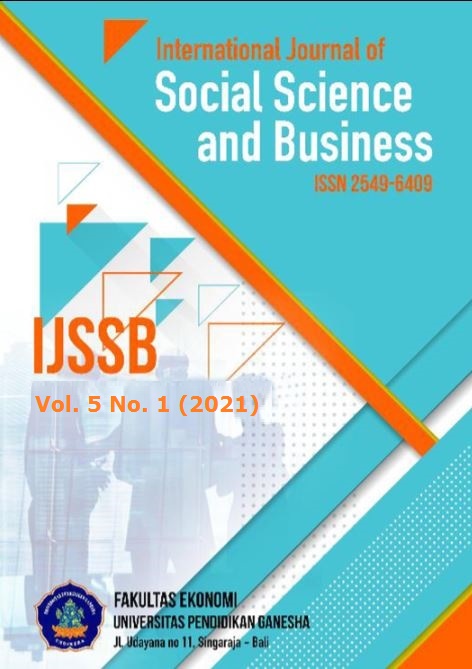Implementation of Product Model, Price, Place, Promotion in Improving Noken Sales (OAP)
DOI:
https://doi.org/10.23887/ijssb.v5i1.29268Keywords:
Marketing Mix, Sales, SMEsAbstract
This study aims to analyze the Application of Products, Prices, Places, Promotions in Increasing Papua Noken Sales. A qualitative / descriptive or narrative approach in this study. Primary data is direct data from the Noken seller. Secondary data, namely indirect data from informants from brochures, magazines, and others. Data collection techniques: Observation, namely observing the object / place of research. Interviewing is conducting a series of questions and answers to informants who know best about the object of research. The questionnaire contains structured questions to informants. The informants in this study were 5 Yanti Noken and Syria Noken. This study shows that application of Product, Price, Place, Promotion for Noken sales in increasing revenue, models that must be applied: Application of Product Strategy Models, Application of Price Strategy Models, Application of Place Strategy Models, Application of Promotion Strategy Models. The four models must be worked on together because these models are interrelated. In this model, promotion in the midst of the Covid-19 pandemic is the most effective. Promotion that must be done by salespeople, especially through the online social media (Facebook). The seller must be responsible for delivering the order to the customer's place. The implementation of this Promotion Strategy Model must be carried out, in order to increase income, particularly the Merauke buying and selling forum. The price must be affordable according to the pockets of the community, and still listen to government advice to stay at home and keep the distance.
References
Abdurrahman, N. H. (2015). Manajemen Strategi Pemasaran. Pustaka Setia.
Amstrong., K. (2016). Dasar-Dasar Pemasaran Jilid 1. Edisi Kesembilan. Erlangga.
Antonella, S. F. (2017). The Effects of Marketing Mix (4P) on Companies’ Profitability: A Case Study of Automotive Industry in France. Journal of Research in Marketing, 8(1), 636-640. https://core.ac.uk/download/pdf/229163745.pdf.
Asdi, A., & Putra, A. H. P. K. (2020). The Effect of Marketing Mix (4P) on Buying Decision: Empirical Study on Brand of Samsung Smartphone Product. Point of View Research Management, 1(4), 121-130. http://journal.accountingpointofview.id/index.php/POVREMA/article/view/93.
Borden, N. H. (1964). The concept of the marketing mix. Journal of advertising research, 4(2), 2-7. https://motamem.org/wp-content/uploads/2019/07/Borden-1984_The-concept-of-marketing-mix.pdf.
Braciníková, V., & Matušínská, K. (2017, December). Marketing mix of financial services from the customers’ perspective. In Forum Scientiae Oeconomia (Vol. 5, No. 4, pp. 36-48). http://ojs.wsb.edu.pl/index.php/fso/article/view/168.
Constantinides, E. (2006). The marketing mix revisited: towards the 21st century marketing. Journal of marketing management, 22(3-4), 407-438. https://doi.org/10.1362/026725706776861190.
Denziana, A., & Yunggo, E. D. (2017). Pengaruh Profitabilitas, Struktur Aktiva, Dan Ukuran Perusahaan Terhadap Struktur Modal Perusahaan Pada Perusahaan Real Estate and Property Yang Terdaftar Di Bursa Efek Indonesia Tahun 2015. Jurnal Akuntansi dan Keuangan, 8(1). http://dx.doi.org/10.36448/jak.v8i1.825.
Dominici, G. (2009). From marketing mix to e-marketing mix: a literature overview and classification. International journal of business and management, 4(9), 17-24. https://papers.ssrn.com/sol3/papers.cfm?abstract_id=1961974.
Finoti, L., Didonet, S. R., Toaldo, A. M., & Martins, T. S. (2017). The role of the marketing strategy process in the innovativeness-performance relationship of SMEs. Marketing Intelligence and Planning, 35(3), 298–315. https://doi.org/10.1108/MIP-01-2016-0005.
Gronroos, C. (1994). From marketing mix to relationship marketing: towards a paradigm shift in marketing. Asia-Australia Marketing Journal, 2(1), 9-29. https://doi.org/10.1016/S1320-1646(94)70275-6.
Hadiwardoyo, W. (2020). Kerugian Ekonomi Nasional Akibat Pandemi Covid-19. Baskara Journal of Business and Enterpreneurship, 2(2), 83–92. https://doi.org/10.24853/baskara.2.2.83-92.
Kalyanam, K., & McIntyre, S. (2002). The e-marketing mix: a contribution of the e-tailing wars. Journal of the academy of marketing science, 30(4), 487-499. https://doi.org/10.1177%2F009207002236924.
Kartini, K. D. (2014). Pemimpin dan Kepemimpinan. PT. Raja Grafindo Persada.
Lahtinen, V., Dietrich, T., & Rundle-Thiele, S. (2020). Long live the marketing mix. Testing the effectiveness of the commercial marketing mix in a social marketing context. Journal of Social Marketing, 10 (3). 357-375. https://doi.org/10.1108/JSOCM-10-2018-0122.
Mukarromah, S. (2018). Implementasi Strategi Bauran Pemasaran Dalam Meningkatkan Volume Penjualan Toko BajuSenamGrosir.com. (Doctoral dissertation, Universitas Muhammadiyah Surabaya).
Poluan, F. M., Mandey, S., & Ogi, I. W. (2019). Strategi Marketing Mix dalam Meningkatkan Volume Penjualan (Studi Pada Minuman Kesehatan Instant Alvero). Jurnal EMBA: Jurnal Riset Ekonomi, Manajemen, Bisnis dan Akuntansi, 7(3). https://doi.org/10.35794/emba.v7i3.24043
Prawita, R., Swasty, W., & Aditia, P. (2017). Membangun Identitas Visual Untuk Media Promosi Usaha Mikro Kecil Dan Menengah. Jurnal Sosioteknologi, 16(1), 27–42. https://doi.org/10.5614/sostek.itbj.2017.16.1.3
Rahmani, K., Emamisaleh, K., & Yadegari, R. (2015). Quality function deployment and new product development with a focus on marketing mix 4P model. Asian Journal of Research in Marketing, 4(2), 98-108. https://www.indianjournals.com/ijor.aspx?target=ijor:ajrm&volume=4&issue=2&article=009.
Rosad, S. D. (2015). Manajemen Pemasaran. In Media.
Silverman, S. N. (1995, May). An historical review and modern assessment of the marketing mix concept. In Proceedings of the Conference on Historical Analysis and Research in Marketing (Vol. 7, pp. 25-35).
Sudari, S., Tarofder, A., Khatibi, A., & Tham, J. (2019). Measuring the critical effect of marketing mix on customer loyalty through customer satisfaction in food and beverage products. Management Science Letters, 9(9), 1385-1396. http://dx.doi.org/10.5267/j.msl.2019.5.012.
Thabit, T., & Raewf, M. (2018). The evaluation of marketing mix elements: A case study. International Journal of Social Sciences & Educational Studies, 4(4). https://papers.ssrn.com/sol3/papers.cfm?abstract_id=3173274.
Van Waterschoot, W., & Van den Bulte, C. (1992). The 4P classification of the marketing mix revisited. Journal of marketing, 56(4), 83-93. https://doi.org/10.1177%2F002224299205600407.
Wang, K., Wang, Y., & Yao, J. (2005, December). A comparative study on marketing mix models for digital products. In International Workshop on Internet and Network Economics (pp. 660-669). Springer, Berlin, Heidelberg. https://doi.org/10.1007/11600930_66.
Yamali, F. R., & Putri, R. N. (2020). Dampak Pandemi Covid-19 Terhadap Ekonomi Indonesia. Ekonomis: Journal of Economics, 4(2), 384–388. https://doi.org/10.33087/ekonomis.v4i2.179.
Yun-sheng, W. (2001). Perfection and innovation of 4P marketing mix–How to evaluate 4P marketing mix. Commercial Research, 5(6). https://en.cnki.com.cn/Article_en/CJFDTotal-BUSI200105006.html.











